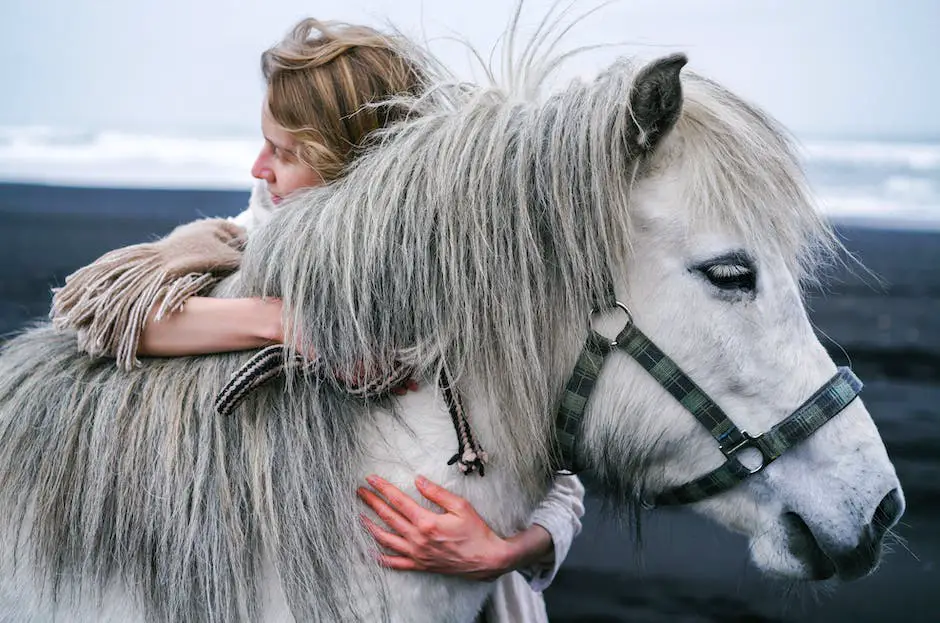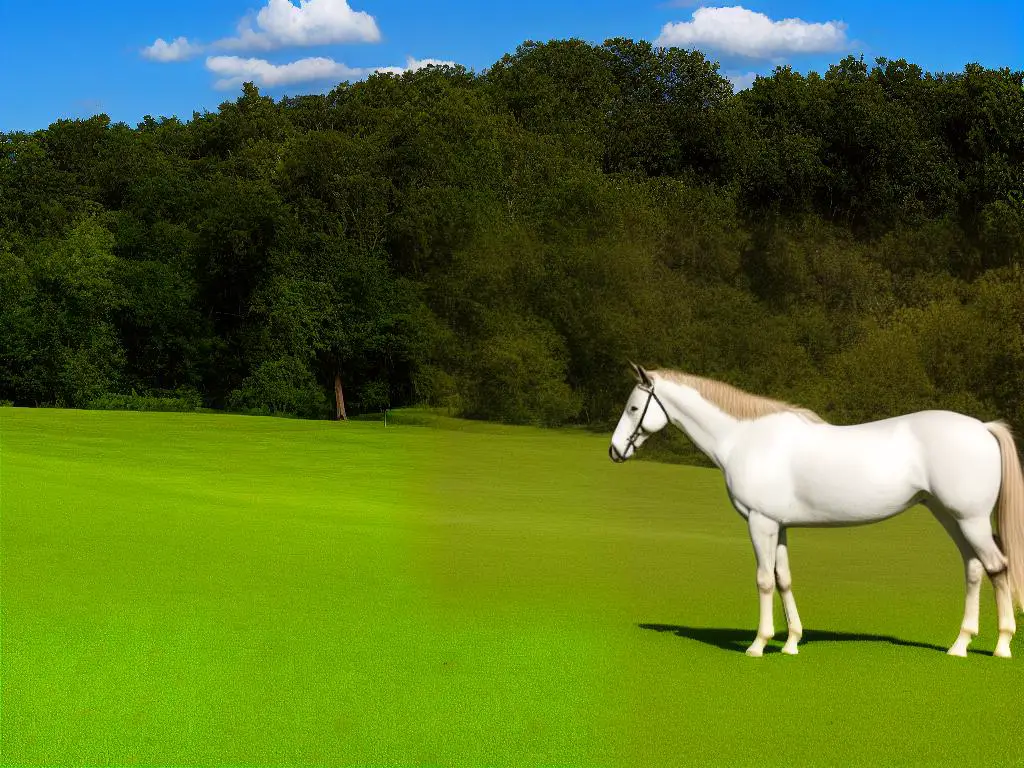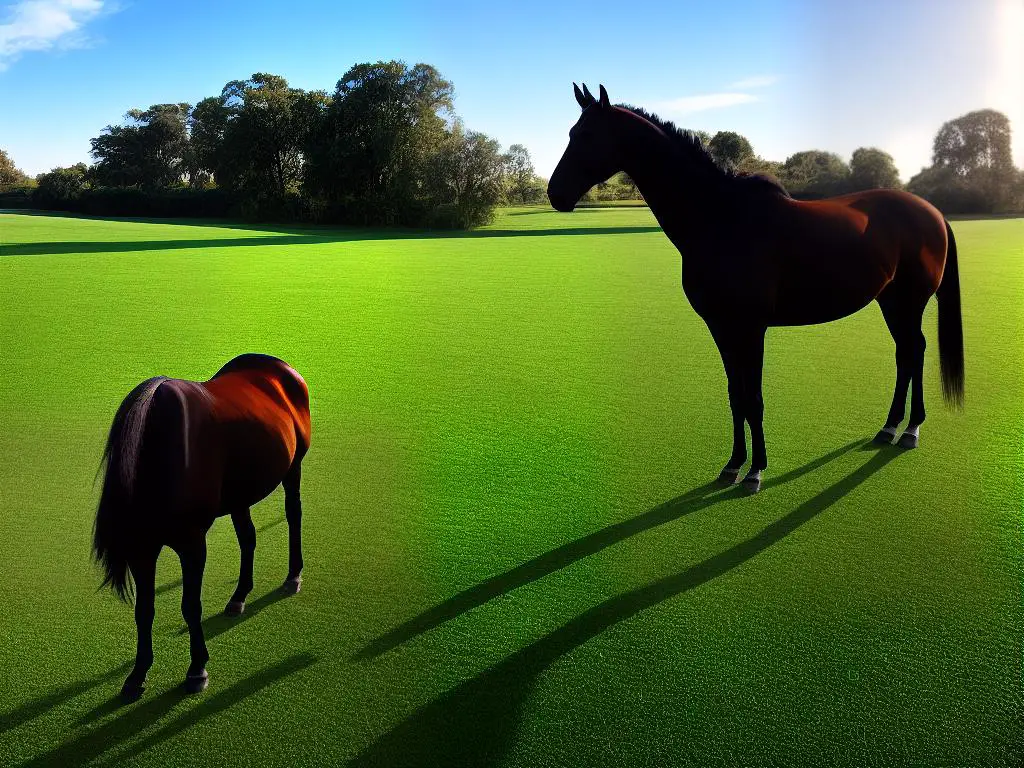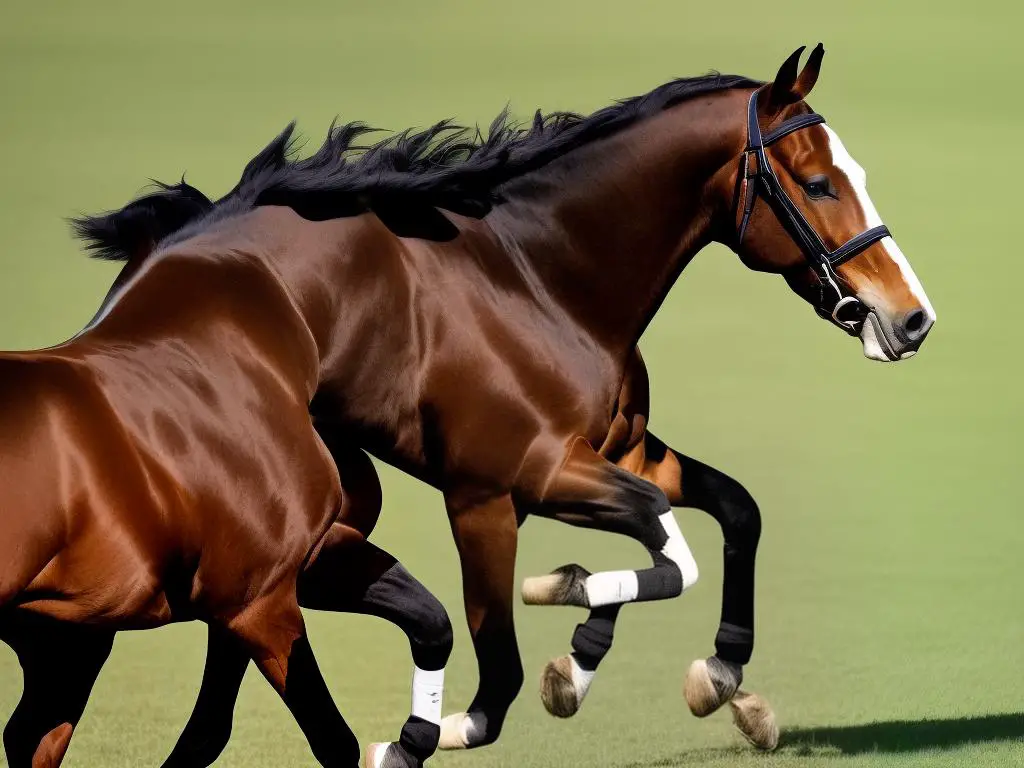Warmblood horses, renowned for their power, agility, and calm demeanor, grace equestrian sports around the world. With historical roots entrenched in various cultures, these remarkable breeds hold an exceptional place both in the field of sport and the hearts of horse enthusiasts. Our exploration traverses their fascinating origins, distinctive characteristics, intricate care and training, and their place in the modern market. Immerse yourself in this captivating journey through the world of warmblood horses, where heritage meets athleticism, commerce, and community spirit.
Table of Contents (Horspedia)
History and Origins of Warmblood Horses
Warmblood Horses
As the name suggests, are a reference to their temperament, which is considered a mix of the “hot-blooded” Arabians and Thoroughbreds and the “cold-blooded” draft horses. Warmblood horses are renowned for their talents in equestrian sports and their controlled pace. Their origin is significant to understand the unique traits that set them apart from their counterparts and make them a preferred choice in equestrian sports.
The Birthplace of Warmbloods
Warmblood horses are primarily European in origin, with each country or region boasting its own type of warmblood such as the Hanoverian from Germany or the Dutch Warmblood from The Netherlands. These regions are deeply tied to the characteristics and abilities of their specific warmblood breeds. For instance, French Warmbloods are known for their lean build and agility, whereas the Dutch Warmbloods are celebrated for their strong suit in dressage and show jumping competitions.
The Evolution of Warmbloods
The evolution of Warmblood horses started from the middle ages when they were used for farm work and as war horses due to their strength and stamina. As technology replaced horses on farms and in wars, breeding goals shifted. Breeders intentionally mated their region’s mares with foreign “hot-blooded” stallions, producing offspring with the desired traits of strength, endurance, and agility.
The earliest warmblood breeding programs date back to the 16th century, such as the Royal Stud of Kladrub in the modern-day Czech Republic. The established studbook registries meticulously recorded mating pairs and offspring to ensure the quality and characteristics of warmblood breeds.
The Role of Warmbloods Through The Ages
Warmblood horses held significant roles in various cultures. During the middle ages, they were integral to agriculture and warfare. Their strength was used for pulling heavy machinery and carrying knights in battles. With industrialization, their role evolved into sports and pleasure riding. Today, they are celebrated athletes and partners in equestrian sports and are a symbol of prestige. Their grace and agility have even found them a place in the arts, particularly in dressage, where horse and rider perform a “ballet” of intricate movements.
Warmbloods in Today’s Equestrian World
In the contemporary equestrian world, warmbloods have become synonymous with excellence and prestige. They excel in three Olympic sport disciplines: dressage, eventing, and show jumping. Their naturally athletic build, combined with their balanced and steady temperament, make them the breed of choice for competitive equestrians. Breeding programs continue to evolve, often with the specific goal of producing the next Olympic champion.
Preservation of Warmblood Breeds
Safeguarding the future of warmblood breeds is fundamental. Through selective breeding and rigorous testing, breed registries worldwide maintain the high quality of warmblood horses. This method, along with strict studbook guidelines, ensures that each new generation of horses continues to meet the performance and health standards set by the registries.
In Conclusion
Throughout history, warmblood horses have been lauded for their strength and agility, transcending their critical role in society. These horses have now ascended to the echelons of equestrian sports, showcasing their athletic prowess at the highest level. The enduring and steadfast efforts of registries and pure-breeding programs endeavor to preserve this legacy. It is through such initiatives that warmblood horses continue to be bred — each one exemplifying the perfect balance, vitality, and strength that distinguish this breed.

Characteristics and Breeds of Warmblood Horses
An Introduction to Warmblood Horses: A Standout Breed in Equestrian Circles
Belonging to a remarkable category of horse breeds known as warmbloods, these creatures exhibit unique characteristics and capabilities that set them apart. These horses skillfully tread the middle ground between the “hot-blood” breeds such as thoroughbreds and Arabians, famous for their speed and endurance, and the “cold-bloods” like clydesdales and percherons, celebrated for their immense strength and size. The breeds falling under the warmblood category encompass a range of horse types, each skillfully encapsulating the finest traits from their “hot” and “cold” horse lineage.
Physical Attributes
Warmblood horses possess refined physical attributes that distinguish them from their hot and cold-blood counterparts. They generally range in size from 15.2-17.3 hands (or 62-70 inches) at the shoulder, offering a sturdy and solid size without being excessively heavy or large. Moreover, warmbloods usually have a rectangular build characterized by a deep chest and strong, long legs. Their sturdy and well-muscled structure makes them ideally suited for equestrian activities such as dressage, show jumping, and eventing.
Temperament
In terms of temperament, warmbloods are renowned for their balanced personalities. They exhibit a docile, even-tempered nature while manifesting the athleticism and vigour of hot-blooded horse breeds. These warmblood characteristics provide them with the resilience and calmness necessary to excel as sport horses. Thus, they are commonly seen in show rings and equestrian competitions owing to their overall versatility and amenable disposition.
Abilities
The abilities of warmblood horses are diverse and multifaceted, a direct result of careful and controlled selective breeding. Their power and stamina stem from their cold-blood heritage, while their agility, speed, and responsiveness spring from their hot-blood lineage. Warmbloods are prized for their impressive jumping ability, smooth and elastic movements, as well as exceptional responsiveness to the rider’s cues. These qualities have made warmbloods particularly popular in many equestrian sports including dressage, eventing, and show jumping.
Breaking Down the Breeds
Considering warmbloods as a large category, numerous breeds exist within this group, each with its unique traits, strengths, and origins. Some of the well-known warmblood breeds include Dutch Warmbloods, Swedish Warmbloods, Danish Warmbloods, and Hanoverians.
- Dutch Warmbloods: Exceptional sport horses, known for their friendly disposition and sheer athleticism. They excel in dressage, show jumping, and harness driving.
- Swedish Warmbloods: One of the oldest recognized warmblood breeds. They’re renowned for their versatility, often standing out in eventing disciplines due to their strength, speed, and endurance.
- Danish Warmbloods: A newer breed, a blend of native Danish mares with Thoroughbred, Trakehner, or Swedish Warmblood stallions. They are favored for their distinctive “floating” gait and are particularly successful in dressage.
- Hanoverian: Originating from Germany, considered one of the most successful warmblood breeds. Hanoverians have extraordinarily athletic bodies with powerful hindquarters, making them exceptional jumpers in both show jumping and eventing.
Introduction
The world of equestrianism is incredibly diverse, and to fully appreciate its depth, one must familiarize themselves with the distinct horse breeds that make up this fascinating sphere. Among them, warmblood horses stand out due to their unique qualities, temperaments, and capabilities. Renowned for their perfect blend of power, agility, and temperament, warmbloods have been meticulously bred over decades, resulting in an exceptional horse breed that is highly celebrated in the equestrian world. From show jumping rings to dressage arenas, warmbloods never fail to captivate equestrian enthusiasts globally owing to their charm and proficiency.

Care, Training and Use of Warmblood Horses in Equestrian
Diving Deeper: Exploring the World of Warmblood Horses
Warmbloods present a unique mix, striking a balance between the fiery spirit of hot-blooded breeds like Thoroughbreds and Arabians and the strength and tranquility of the robust, cold-blooded draft horses. This one-of-a-kind fusion endows warmbloods with the agility, endurance, strength, and dependability necessary to excel in various equestrian disciplines. This includes disciplines such as show jumping, dressage, and eventing. Indeed, the versatility, athleticism, and temperament of warmblood horses make them an intrinsic part of the equestrian landscape.
Warmblood Horse Care
To ensure the well-being and optimum performance of warmblood horses, proper care is essential. Their dietary needs vary depending on their age, workload, and health status. Generally, warmbloods need a balanced diet of quality hay, grain, and ample fresh water. Regular feeding times, usually three times a day, should be maintained. Adding supplements or fortified feeds can also help to meet their nutritional requirements.
Grooming is another key aspect of care. Regular grooming not only helps in keeping the horse clean but also enhances circulation, strengthens the bond between horse and handler, and gives the opportunity to spot any health problems early. Warmbloods, having thicker coats, need thorough, regular grooming, especially during shedding seasons.
Warmblood Horse Veterinary Care
Regular veterinary check-ups are also an important part of a warmblood’s care regimen. Just like any other large animal, they are susceptible to a range of problems such as colic, lameness, respiratory diseases, and so on. Regular deworming and vaccination against equine diseases like equine influenza, tetanus, and others are crucial. Dental checks should be a part of the regular veterinary visit as well, as dental problems can lead to eating difficulties and affect overall health.
Training Warmblood Horses for Equestrian Disciplines
Proper training is pivotal in harnessing the capabilities of warmblood horses. Their training should work to develop their natural athleticism while emphasizing their calm and cooperative nature. It is not uncommon to start their training for dressage and jumping from a young age itself, emphasizing the balance, flexibility, strength, and precision.
In the case of dressage, for example, warmbloods excel because of their larger strides and willingness to work. A good example of a successful warmblood in dressage would be the legendary Totilas, a Dutch Warmblood, who, with his rider Edward Gal, achieved numerous world records and titles in the discipline.
Warmblood Horses in Jumping and Eventing
Warmbloods are also highly capable in show jumping and eventing. Their powerful hindquarters and agile nature make them suitable for the fast-paced and high-jumping nature of these events. The Holsteiner, an example of a warmblood breed, is particularly popular in jumping because of its power and scope.
A notable example of a successful warmblood in jumping is Big Star, a KWPN (Royal Dutch Sport Horse) ridden by Nick Skelton. They won the individual gold medal in jumping at the 2016 Rio Olympics.
Final Thoughts
To sum up, warmblood horse care and training is indeed a thorough commitment. It necessitates an appropriate mix of diet, grooming, medical attention, and specialized training. Done correctly, the outcomes can be exceptional. These nimble, adaptable, and temperamentally balanced horses continue to triumph in numerous equestrian disciplines across the globe. Their unique characteristics and compatibility with the demanding aspects of equestrian sports significantly contribute to their endurance and success.

Warmblood Horses in the Market
Introducing Warmblood Horses: All about Agility, Power, and Elegance
Warmblood horses, celebrated for their agility, power, and elegance, are a highly valued breed in the domain of equestrian sports. The most commonly showcased in the disciplines of dressage, jumping, and eventing. Naturally, their high regard and demand give rise to crucial considerations about pricing and market dynamics. No matter if you’re contemplating to own, breed, or even just to appreciate these equine beauties, understanding these aspects are critical.
Price Range and Factors Influencing Their Value
The price of warmblood horses is susceptible to a wide range, influenced by various factors. As a broad estimate, the price can range anywhere between $15,000 to several million dollars. The age, pedigree, training level, health, temperament, and competition record of the horse drastically influence this price. A well-bred, young warmblood with no training can have a starting price of around $20,000, while a proven high-performance competitor can price into the millions.
Considering the pedigree, warmbloods with parents who have shown exemplary prowess in sport or breeding can command significantly higher prices. Training is another contributing factor. A warmblood horse that has been professionally trained and shown success in competitively challenging scenarios will increase the horse’s market value.
Last but not least, health and temperament play a role in a horse’s value. A healthy horse with a sound temperament will invariably appeal more to potential owners, thereby increasing its price.
Tips for Buying or Breeding Warmblood Horses
Buying or breeding a warmblood horse is a substantial commitment. For purchasing, look for reputable breeders or sellers who can provide full transparency about the horse’s background, health, and temperament. Don’t hesitate to take your time and deliberate over your decision. Ride and interact with the horse multiple times to ensure you’re compatible.
If you intend to get into breeding warmbloods, in-depth knowledge about the desired traits, ideal pedigrees, and proper care is vital. Seek professional advice if you aren’t experienced, and make sure the offspring will have likely buyers in the market. Breeding warmbloods isn’t just about producing a horse; it’s about upholding and improving the standard of the breed.
The Warmblood Community
Warmbloods aren’t just a breed of horses—they’re a community. There are countless clubs and organizations around the world dedicated to specific breeds of warmbloods, offering services from certification to competitions. Moreover, they often provide platforms for owners and riders to interact, develop the culture, and enhance the heritage of the warmblood equestrian.
Competitions play a big role in this warmblood community. Dressage, show jumping, and eventing are major sports involving these horses, with local, regional, national, and international level events organized regularly. Apart from the thrill of the competition, these events serve to bring together enthusiasts, breeders, and trainers, thereby fostering the community around these majestic creatures.
Additionally, there are several conservation efforts dedicated to maintaining the quality and genetic diversity of warmblood breeds. These initiatives ensure these splendid horses remain a vibrant part of our world, both today and for generations to come.
Conclusion
With all these factors in mind, it’s clear that the commercial and social aspects of warmblood horses are intricately interwoven. Whether you’re an owner, a breeder, or an admirer, understanding the market dynamics and community implications can significantly enhance your warmblood equestrian experience. It’s not just about the love for the breed, but also about supporting and being part of a beautiful, passionate community.

Delving into the rich tapestry of warmblood horses, we’ve journeyed through the annals of their history, considered their varied characteristics, and gained insights into their care and training for equestrian endeavors. We’ve also explored the dynamics that encompass the value of these magnificent creatures within the market. Warmblood horses continue to inspire and amaze, embodying a unique blend of historical prominence, athletic excellence, and communal importance. This exploration invites us to appreciate these noble creatures even further and understand their continued relevance in our society. The world of warmblood horses is indeed a riveting domain filled with power, grace, and extraordinary stories.
